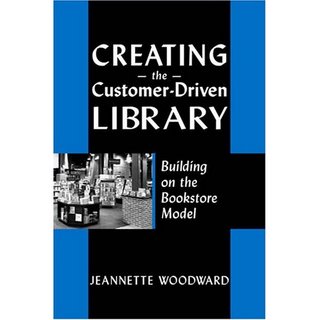
Jeannette Woodward's Creating the Customer-Driven Library: Building on the Bookstore Model offers fascinating insights into the emerging bookstore-concept library. Woodward argues that, for the library to not only survive, but thrive, it must adapt to the retail bookstore model of tailoring services and products to the tastes of the patron. The Richmond Public Library has adopted this philosophy almost to the tee. However, what makes it unique also makes it controversial. Here's why:
(1) Customers service - The RPL prefers "customer" over "patrons." It's all semantics, but behind this innocuous phrase is a pure concept of pleasing the person who steps through the gates. In a way, is not every library's mandate essentially the same, particularly for "public" libraries?
(2) Merchandise - Calling books "products" seems weird, but referring to them as "merchandise" might be ludicrous for some. Put it any way you like, a duck is a duck. Quack, quack. Nonetheless, language does make a difference in the way human cognition operates. By focusing on promoting the items in the library, it does highlight the importance of what is at stake. Is it a bad thing to "sell" what you have?
(3) Self-service checkouts - 95% of the circulation is done by self-service automation. Even holds are self-service. Understandably, traditionalists are upset that such a trend will ultimately displace the library staff, namely the paraprofessional and support staff. The RPL disagrees. It believes that such a system frees up staff to do other customer-service tasks.
(4) "Walking the floor" - In adopting this retail concept, the customer will always be served and the products continually replenished. Staff members are to proactively walk around the stacks and offer assistance to those in need. However, at the RPL, this is the case for certain sections, namely the Popular Titles section, where it is an amazingly dynamic area of the building.
(5) Automated scheduling - Democracy or pseudo-outsourcing? Call it what you will, by allowing auxiliary staff to pick and choose their own schedules, the RPL allows ultimate flexibility. But why not just hire more full-time staff instead of piecemeal? By doing so, the RPL argues that it maximizes on the full potential of its open hours (it has the longest hours of any public library system in North America). But does it to save in other areas?
(6) Themes - To a certain extent, this is not new. However, RPL takes it to another level, and offers new themes regularly, such as "Asian Reads" or "Biography Lovers." In such themed areas, books are picked off the shelves and placed together.
(7) Outsourcing of cataloguing - RPL doesn't create its own catalogues. Nor does it even copy-catalogue. Everything is done by contract. Does it work? Well, it does free up the essential revenue for other areas, such as the latest DVD's and more newer titles. In the end, the question is, does the customer/patron benefit?
(8) Reference - The traditional reference desk, where the librarian snuggly sits for hours on end, quietly working away on the computer is replaced by Information kiosks.
(9) Signage - Not unlike bookstores, RPL's sign are sharp and attractive. The signs say it all. "Kids Place" replaces the traditional Children's section. Is it a sellout to the bookstore? Or are we simply using a good, simple idea and applying it to the library?
(10) Coffee machines - Traditionalists cringe at the thought of drinking in the library. However, RPL promotes it by having machines right inside. Although somewhat teleological, Woodward argues that since patrons are going to drink/eat at home with the books, we should perhaps be at peace with the inevitable.
So far, RPL has been very successful. In my opinion, location is everything. Gate counts are one of the highest in Canada. Yet, what works in Richmond might not work in Abbotsford or Victoria. The demographics in Richmond make sense: young, hip, urban, and middle class. The sleekness of the RPL suits such a chic clientele. But will such a model last? Time will tell.



